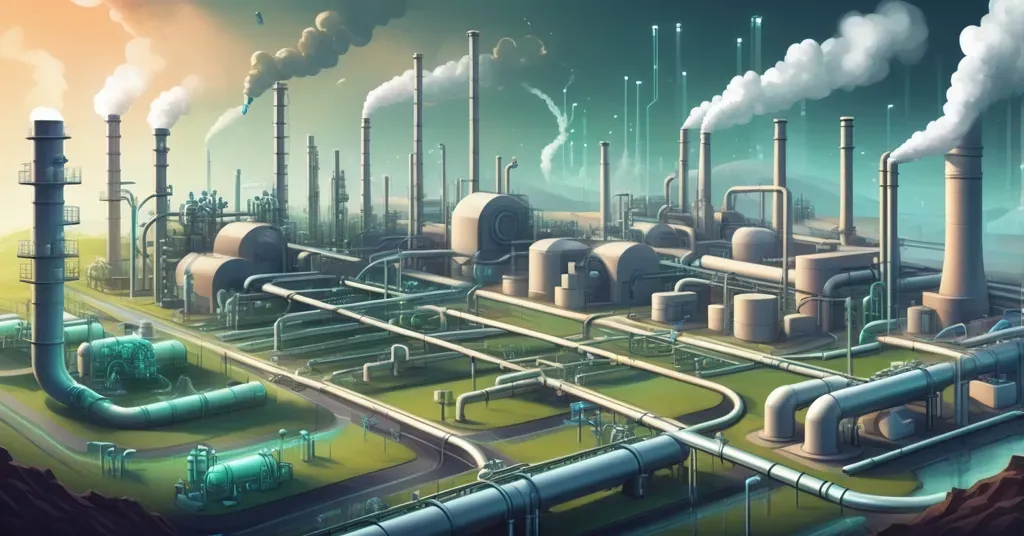
Carbon Capture and Storage in 2025
Carbon Capture and Storage (CCS) is crucial for reaching net-zero emissions, with ambitious targets set for 2050. Despite progress, challenges like funding and policy support persist.
Imagine capturing 6 billion tons of CO2 annually by 2050 – that's the scale of the challenge ahead for Carbon Capture and Storage (CCS). As we progress into 2024, CCS continues to gain ground as a pivotal technology in the fight against climate change. Despite significant advancements in policy support and industry interest, the journey to a net-zero economy remains fraught with challenges and opportunities.
Progress in CCS
The International Energy Agency (IEA) underscores the urgency of CCS, suggesting that 6 billion tons of CO2 need to be captured yearly by 2050 to align with the Paris Agreement's goals. This ambitious target reflects the critical role CCS must play in our global climate strategy.
In the United States, CCS capacity is expected to increase fourfold by 2030, driven by significant funding opportunities like the $1.7 billion for carbon capture demonstration projects and $1.2 billion for direct air capture (DAC) hubs. Europe anticipates an even more dramatic increase, with a 23-fold rise in capacity, supported by substantial funding from the EU and individual countries. Projects like Northern Lights, Porthos, and Aramis in Europe exemplify this momentum.
Challenges Facing CCS
Despite this progress, fewer CCS projects are reaching final investment decisions (FIDs), primarily due to funding constraints and concerns about economic viability. The complexity of inter-project dependencies and the need for streamlined permitting processes add to these challenges.
The oil and gas industry currently dominates CCS demand, primarily for enhanced recovery, although its role is expected to expand into hydrogen production and reduced-emission power generation. While only 2% of captured CO2 is currently utilized (Carbon Capture, Utilization, and Storage, or CCUS), the majority is stored permanently underground. Direct Air Capture, though promising, remains energy-intensive and not yet economically scalable.
The Future of CCS
The CCS supply chain, encompassing capture, transport, utilization, and storage, requires comprehensive attention to ensure robust growth. As one expert notes,
Addressing project-on-project risk through the alignment of projects across the entire CCS supply chain is crucial for robust CCS growth.
The future may see a shift towards CO2 utilization rather than permanent storage, as highlighted by another insight:
The future promises the utilisation of CO2 rather than its permanent storage underground.
Policy support remains a linchpin for CCS development. Advances in this area will be critical, especially in this early market stage. As noted,
Advances in policy support will be critical for CCS growth in this early market stage, and companies could lobby for it.
The US requires clearer guidelines, while Europe needs a more straightforward commitment to foster growth. The political landscape, influenced by events like the policies of the Trump administration and upcoming elections, adds another layer of complexity to the global CCS trajectory.
Actionable Insights
- Advocate for clearer policy guidelines in your region to support CCS growth.
- Stay informed about CCS projects and their impact on carbon emissions by visiting our daily climate change blog at OpenExO Climate Feed.
Key Takeaways and Questions
- What are the current challenges facing the CCS industry?
The CCS industry faces challenges such as complex permitting, inter-project dependencies, and funding issues, which hinder projects from reaching final investment decisions.
- How is CCS expected to evolve in the US and Europe by 2030?
The US anticipates a fourfold increase in CCS capacity, while Europe expects a 23-fold increase, driven by significant projects and policy support.
- What role does the oil and gas industry play in CCS demand?
The oil and gas industry currently dominates CCS demand, primarily for enhanced recovery, with future expansions expected in hydrogen production and reduced-emission power generation.
- Why is policy support crucial for the growth of CCS?
Policy support is essential for CCS growth as it provides the necessary framework and incentives to overcome early market stage challenges and encourage investment.
- How can the alignment of projects across the CCS supply chain be improved?
Improving alignment requires better coordination and communication among stakeholders to mitigate inter-project dependencies and streamline the entire CCS process.
- What are the potential environmental and economic impacts of shifting from CO2 storage to utilization?
Shifting to CO2 utilization could reduce the need for permanent storage, potentially lowering environmental risks, while economically, it could open new markets and revenue streams.
- How will upcoming elections and policy changes affect CCS development globally?
Upcoming elections and policy changes could either accelerate or hinder CCS development, depending on the political will and commitment to climate goals in different regions.
By exploring the potential of CCS and advocating for supportive policies, we can take proactive steps towards a net-zero future. Join the movement and stay updated on the latest climate change solutions by visiting OpenExO Climate Feed.
ExO Insight Newsletter
Join the newsletter to receive the latest updates in your inbox.









